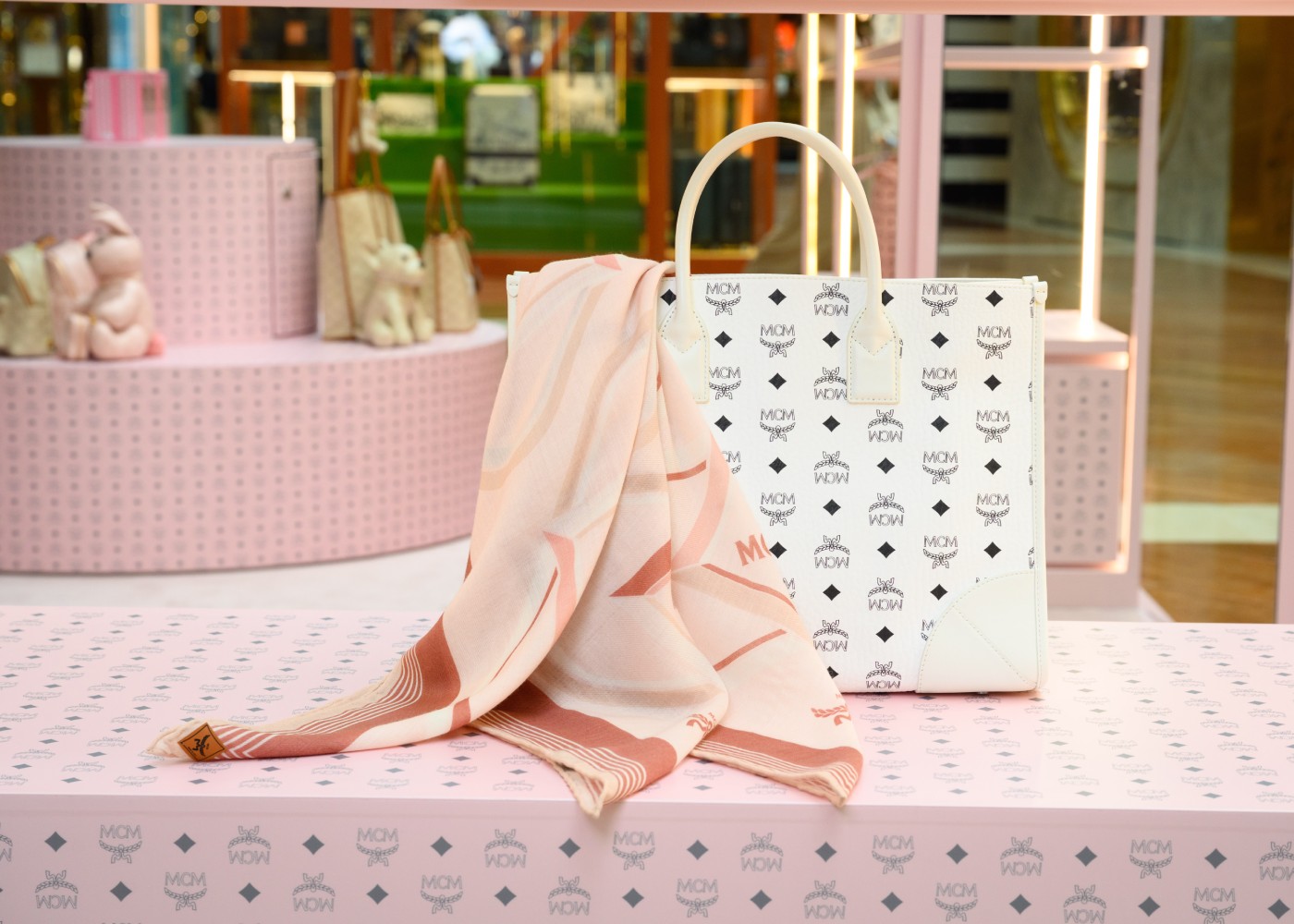CATALYST 2025: The Next Big Ideas in Design, Singapore Polytechnic
Published on April 14, 2025 | by DSGN arcHive
We spoke to Singapore Polytechnic’s next-gen designers to see where design is heading. Here’s what we found…
What if the future of our cities was shaped by fearless young minds—unafraid to challenge convention and ready to reimagine the world around them? At CATALYST 2025, Singapore Polytechnic’s annual graduate showcase, that very vision came to life. Presented by the School of Architecture and the Built Environment (ABE), the exhibition unveiled a breathtaking collection of 180 final-year design projects. Each one offered a bold, imaginative response to pressing real-world challenges. From sustainable urban planning to inclusive design for communities, these projects went far beyond the classroom. They reflected the ideals, ingenuity, and purpose of Singapore’s next generation of architects, interior designers, and landscape architects.
Driven by passion and guided by purpose, these students invested months into rigorous research, fieldwork, and countless rounds of design development. Collaborations with leading industry partners—including the Urban Redevelopment Authority (URA)—provided invaluable real-world insight and professional mentorship. As a result, the students created forward-thinking solutions that are both visionary and practical. We visited the showcase to explore the most compelling projects—and spoke to several student designers to understand what inspired their ideas and how they developed well-rounded, contextually grounded design concepts.
Scroll down for a closer look at these brilliant young changemakers…
Scroll down for the full scoop or jump straight to these highlights:
Diploma in Architecture
1. Traversa by Aaron Lim Yoke Chuan
Buildings should be designed to inspire and support their occupants, offering both sustainability and a comfortable environment. For educational buildings, this means fostering passion and curiosity, not just providing space for learning. As the Architecture, Engineering, and Construction (AEC) industry grows, it’s crucial to prioritise the purpose of buildings and meet the needs of those who use them.
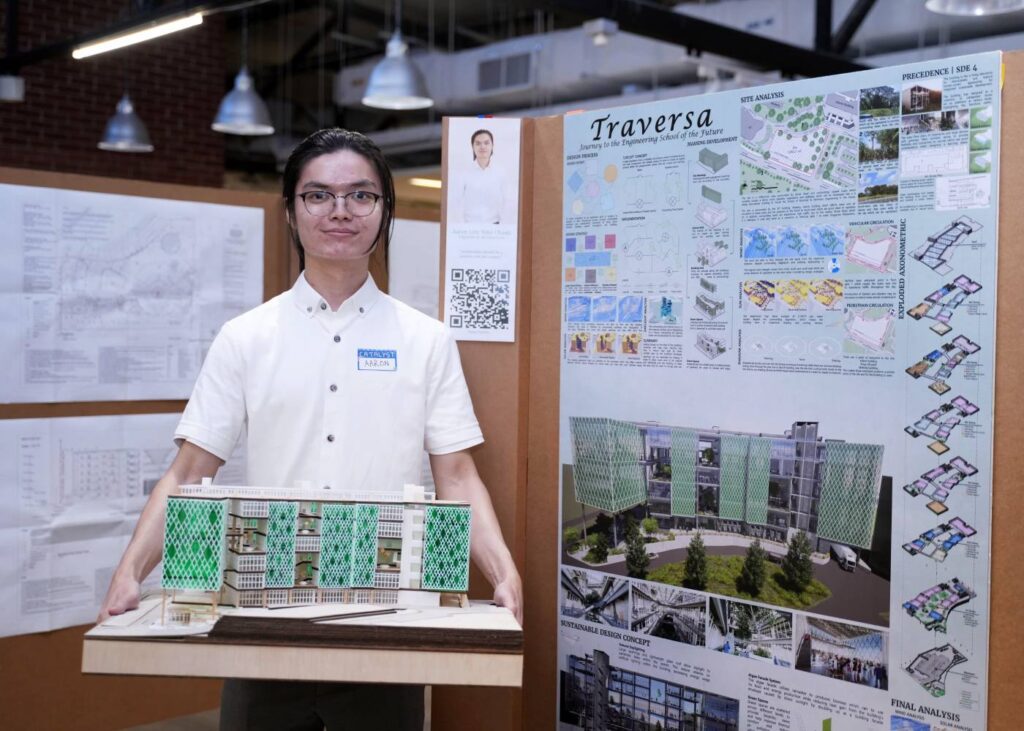
Aaron: “The inspiration came from a desire to create a sense of adventure and excitement within the learning environment, sparking motivation and passion for the specialised courses at the Electrical & Electronic Engineering (EEE) school, while also incorporating sustainable designs to balance aesthetics with sustainability. Hence, I aimed to develop a concept that could be linked back to the EEE school, paying homage to it while keeping things simple and relatable. This is when I remembered a basic electrical series circuit I learned in science class during my secondary school years.
By imagining the wire as pathways and variable resistors as a medium influencing travelling speed, I utilised these elements to design a space with a journey-like experience that aims to achieve an adventurous and exciting experience. In addition, prevailing wind directions and high direct sunlight exposure to the site were considered to mitigate harsh temperatures and environmental conditions, while allowing for wind flow and suitable daylighting levels. This creates a design concept that suits today’s students’ needs and experiences in learning, as it helps them explore and discover what they are truly interested in, fueling their passion for the course without much obstruction.”
2. The Nexus Orb by Daniel Lai Wei Xuan
Buildings should be designed to inspire and support their occupants, offering both sustainability and a comfortable environment. For educational buildings, this means fostering passion and curiosity, not just providing space for learning. As the Architecture, Engineering, and Construction (AEC) industry grows, it’s crucial to prioritise the purpose of buildings and meet the needs of those who use them.
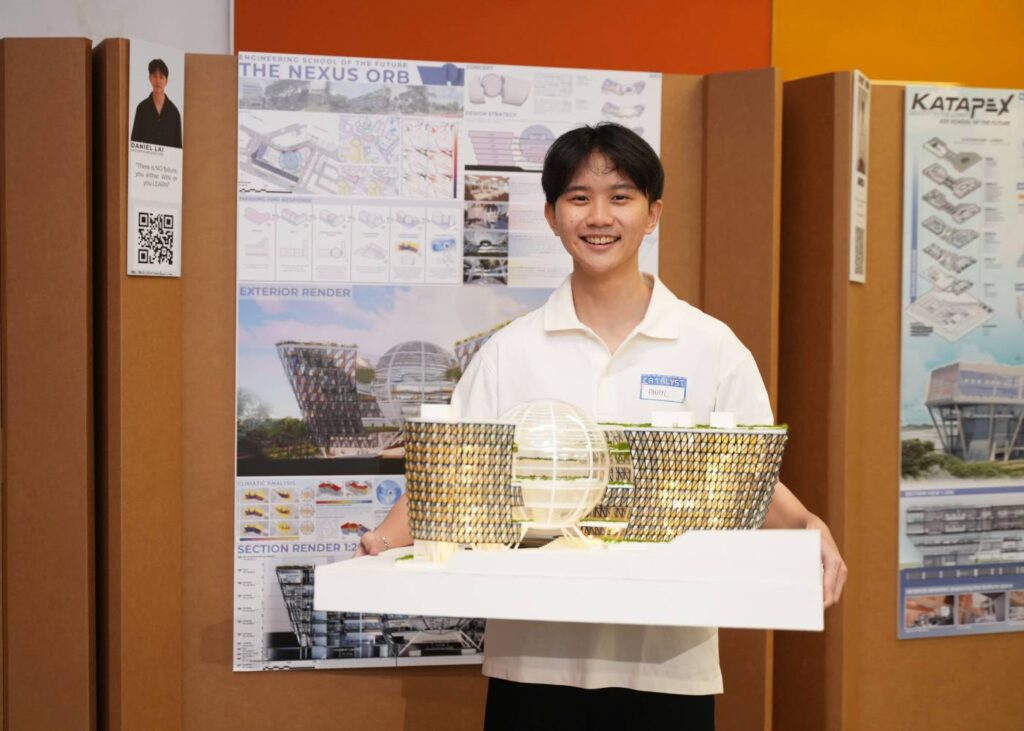
Daniel: “The inspiration for my project stemmed from addressing the challenges faced by Electrical & Electronic Engineering students. My goal is to design a school where students feel at home, take pride in their institution, and develop a unique sense of identity. I want to create an environment that not only supports their academic journey but also fosters a sense of community and creativity.
My design concept draws inspiration from two iconic buildings: the Marina Bay Sands Apple Store and the Aula Medica in Sweden. The distinctive dome of the Apple Store influenced my decision to create a central hub that serves as the heart of the school, fostering collaboration and connection. From the Aula Medica, I adopted the idea of embracing natural light rather than blocking it. Using intricate stained glass, I incorporated dynamic reflections that change throughout the day, enhancing the spatial experience.
For sustainability, I was inspired by the Aula Medica’s slanted facades, which provide seamless shading and reduce heat gain. This passive design strategy improves energy efficiency while maintaining a comfortable indoor environment. By blending these architectural influences, my project creates a forward-thinking, identity-driven space that meets both the functional and emotional needs of the students.”
3. PIXEL by Kayden Ang Yuan Xi
The current School of Electrical & Electronic Engineering has insufficient space for students to self-study, collaborate on group projects, or consult. The lack of greenery, natural light, and ventilation also makes study spaces unfavourable. Students may feel unproductive and lack focus during their lessons. PIXEL addresses these key issues by creating a school environment that promotes student well-being and interaction.
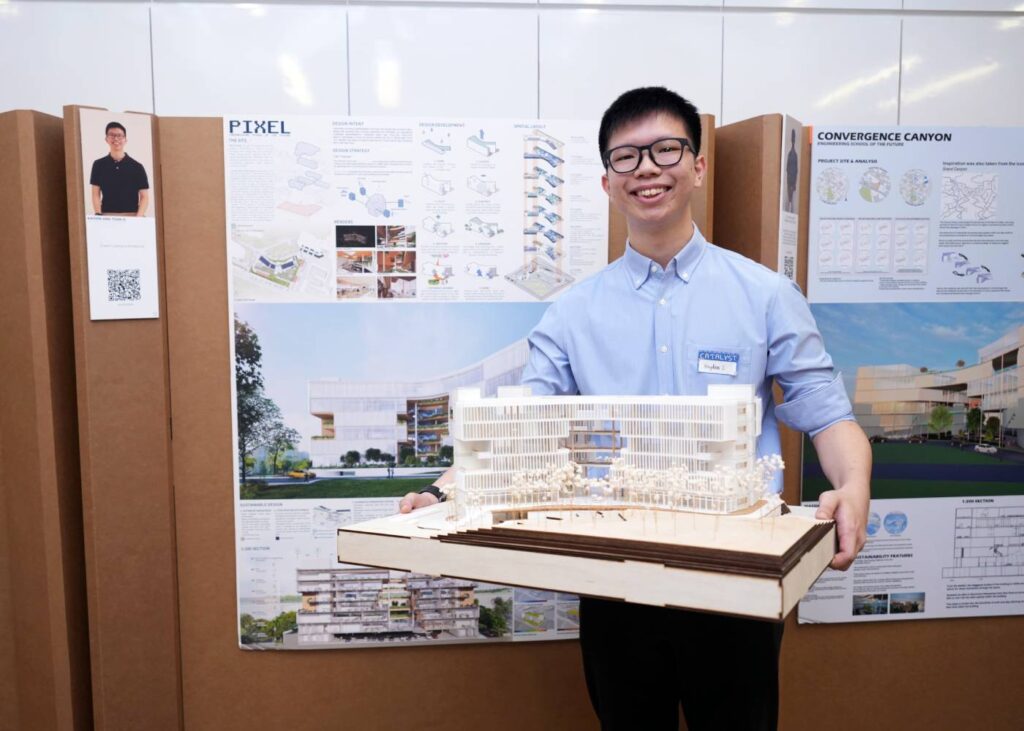
Kayden: “Pixel takes inspiration from a fissure. The “fissure” creates a central atrium that reveals the vibrant school culture and establishes a pedestrian artery that runs through the central axis of the building. With dedicated exhibition areas on the ground floor, the atrium is filled with activity, prompting interaction and sparking ideas between students. While Corner Nooks, secluded from the busy central atrium, provides a private space for students to unwind and have discussions.
The design concept is derived from an understanding of the current concerns with the existing engineering school, such as insufficient spaces for students to self-study, collaborate on group projects or have consultations. Apart from this, the lack of greenery, natural light and ventilation make studying conditions unfavourable, causing students to feel unproductive and lose focus during lectures or lab sessions. PIXEL addresses these issues by offering collaborative learning environments, fuelling creativity whilst providing a place of refuge from the hectic work and study life. PIXEL is envisaged as a peaceful environment where teachers, students and faculty can lounge and converse freely. Additionally, PIXEL is situated at a prominent circulation node, surrounded by multiple pedestrian pathways and bus stops, making it a key gateway to Singapore Polytechnic.”
Diploma in Interior Design
4. Eruditare by Yong Xin Lin Charissa
The abrupt shift to remote learning and extended periods of isolation have highlighted the critical need for adaptive and inclusive spatial design in educational environments. These experiences have propelled us to rethink how we learn in spaces that cater to the dynamic needs of students, educators, and communities.
This project envisions a new paradigm in educational design, where the integration of sustainable principles and community-centric approaches fosters learning environments that enhance academic performance, promote social inclusivity, and support overall well-being. This project hypothesises innovative school scenarios where sustainable elements and flexible designs cultivate enriching and resilient spaces, capable of adapting to both immediate educational needs and future challenges.
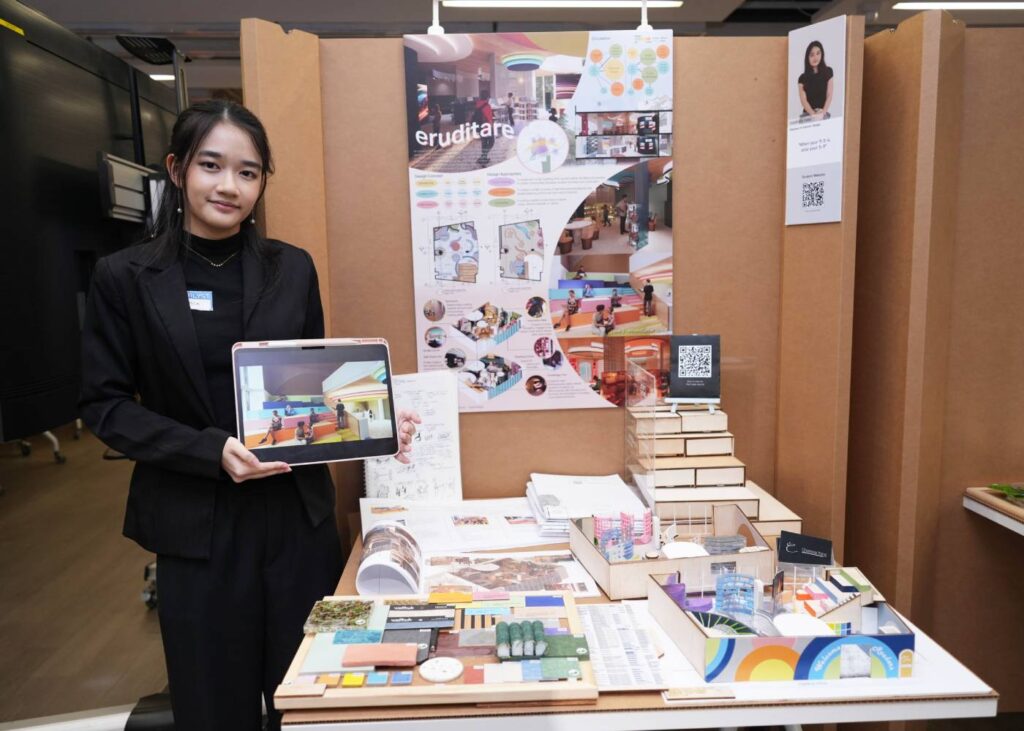
Charissa: “This project was a collaboration with a Ministry of Education (MOE) primary school. Knowing that my project design would directly impact the students’ learning experience and their love for reading added a newfound depth of meaning for me. This inspired me to envision a unique library space that fosters a positive learning environment, enriches the educational experience, and cultivates a passion for reading.
It also brought me back to my own primary school days when I had the opportunity to rethink the design of my school library. During visits to public libraries, I observed how children interacted with the space, noting their different personas and reading habits. I drew inspiration from museums, studying strategies and activities that captivate young minds while maintaining an educational and functional purpose. I also explored how technology could be integrated with physical elements to enhance the experiential reading journey.
To create the concept and design of each spatial zone, I focused on the simplicity of activities for younger students while introducing complexity in the layout. My goal was to create a space that caters to all reading preferences — for those who prefer reading alone, discussing ideas with friends, seeking guidance, or even encouraging those who typically avoid reading to develop an interest in it.”
5. Inclusivity – Fostering Unity Through Innovation by Muhammad Azmi Bin Khalid
As we stand at a new juncture in spatial design, shaped by our collective experiences during the pandemic, it is evident that the spaces we choose to engage with—or disengage from—have profound implications on our well-being and social dynamics. The months of isolation and the necessity of staying indoors have significantly influenced our perception of and interaction with built environments, compelling us to rethink the future of spatial design.
This project envisions a future where sustainability principles and community-centric design coalesce to create adaptive workspaces that promote social inclusivity, enhance communal interaction, and support individual well-being. This project hypothesises scenarios where integrating natural elements into urban work environments boosts productivity and facilitates social interaction and collective resilience.
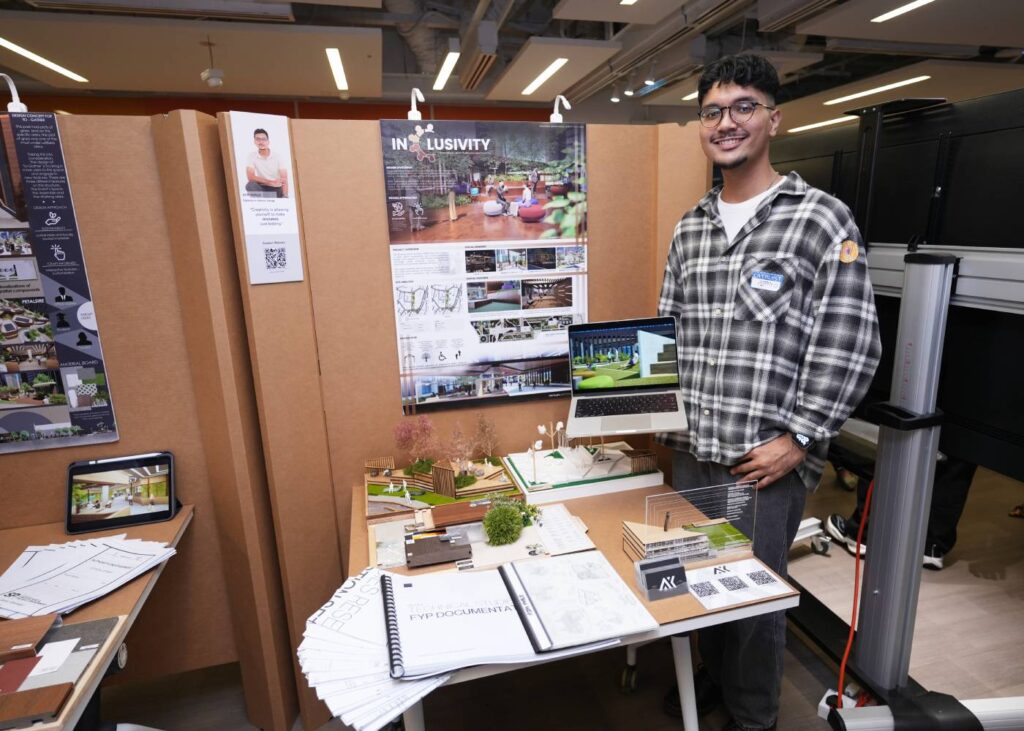
Muhammad: “My project, “Inclusivity – Fostering Unity Through Innovation”, was inspired by the need to rebuild and strengthen connections among Singaporean workers who missed opportunities to forge new friendships during the COVID-19 pandemic. The goal is to encourage workers to return to the office after an extended period of remote work, as many have become more comfortable working from home.
Since the pandemic has subsided in Singapore, my design focuses on reintegrating users into active social environments where they can easily meet new people. To achieve this, I have carefully curated spaces that utilise linear forms to promote ease of movement and interaction. These designs ensure that the space is both functional and welcoming for diverse groups, while activities offered help improve mobility and mental well-being.
Ultimately, my design reimagines public spaces as community-driven environments that promote well-being and shared experiences in a post-pandemic world.”
Diploma in Landscape Architecture
6. Robin Birdscape by Yeo Mei Zhen
Robin Birdscape celebrates the Oriental Magpie Robin and Singapore’s bird-watching heritage by creating a vibrant urban corridor where nature and community meet. Inspired by the historic Tiong Bahru Bird Corner, the design features rain gardens, bioswales, and native plantings to support the Magpie Robin’s habitat and manage stormwater sustainably. The space encourages interactions between wild and domestic birds, reviving traditional bird-watching culture with areas for resting and bird-singing competitions. The project integrates ecological balance, historical preservation, and cultural engagement, fostering environmental awareness and reconnecting residents with nature.
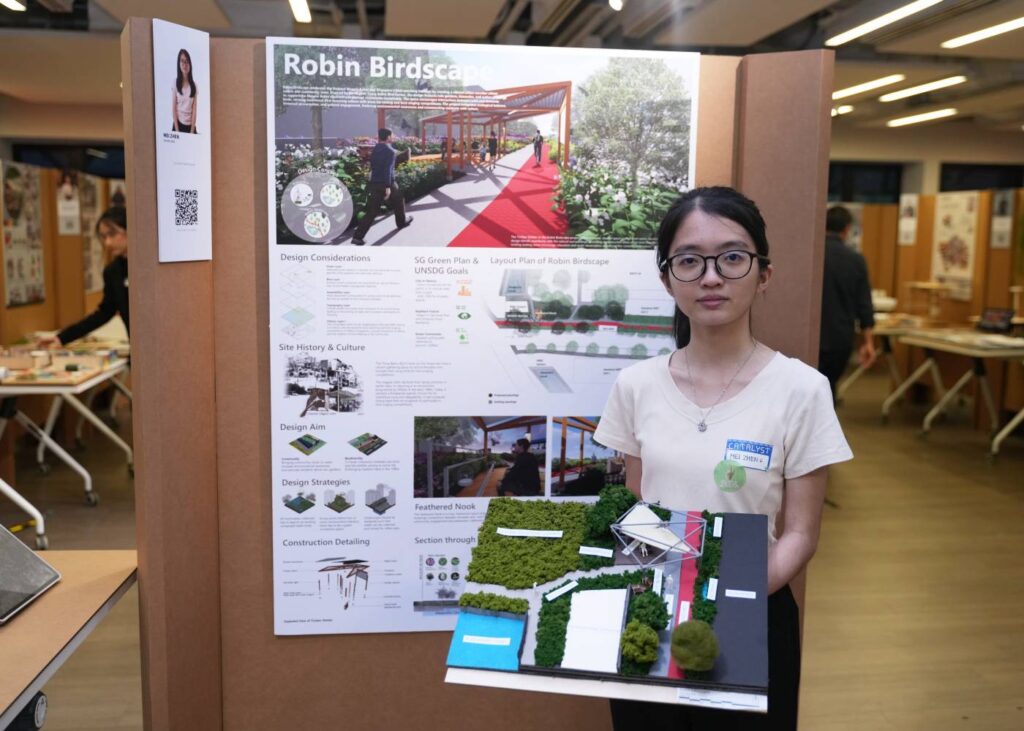
Yeo Mei Zhen: “While exploring Zion Road, I discovered traces of the historic Tiong Bahru Bird Corner. Curious about its past, I researched its history and realised how vibrant it once was—a gathering place where bird enthusiasts bonded over bird-singing competitions. This sparked the idea for Robin Birdscape in the hope of reviving this cultural legacy while promoting urban biodiversity. The project aims to bring back Singapore’s bird-watching traditions while integrating nature into the city. The historic Tiong Bahru Bird Corner once fostered a strong connection between people and wildlife. I want to recreate that spirit along Alexandra Canal, transforming an underused space into the longest neighbourhood bird corner.
Robin Birdscape incorporates rain gardens and native plants to attract the Oriental Magpie Robin, a bird that was once common in Singapore but has become less visible in urban areas. By encouraging interactions between wild and domestic birds, the space revives bird-singing traditions while promoting conservation awareness. Dedicated cycling paths further connect the area to a broader green-blue network. Through this project, I aim to weave together nature, culture, and community, restoring the bird-watching culture while creating a space where both wildlife and people can thrive.”
7. Reverie by Chong Kar Hee
Located under the Newton Flyover, Reverie is a rejuvenating space in nature, offering a rest stop for users midway through their journey. Located near high-traffic areas like Newton MRT and neighbouring schools, it provides a quiet escape under the flyover where people gather by the water. The site highlights the coexistence of urban life and nature, with the Rochor Canal serving as a serene backdrop. Reverie transports visitors into a dream-like state, offering calming views of the canal, waterbirds, and soothing sounds, providing a sense of calm and well-being before continuing their journey.
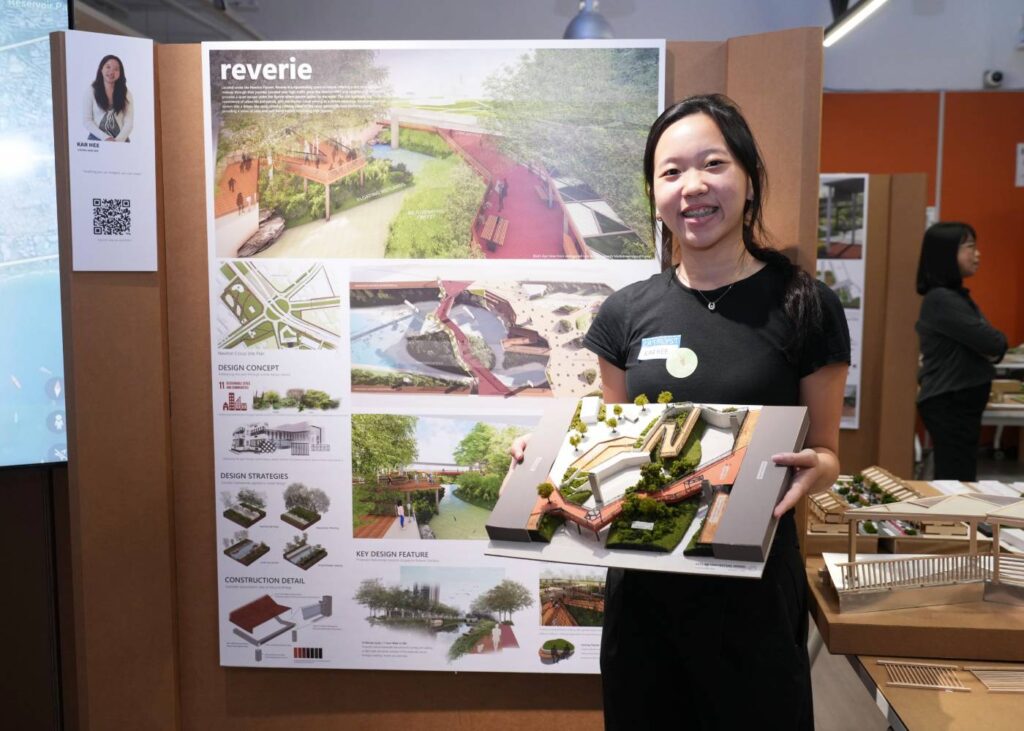
Chong Kar Hee: “When I first visited Newton, I was navigating the busy crossings in search of a potential site for my Final Year Project (FYP). Amidst the hustle and bustle, I stumbled upon a quiet, hidden spot under the flyover along the canal. It was surprising to see people lounging on mats, enjoying a meal in the shade. The view from the bridge crossing the canal was breathtaking—a peaceful oasis nestled within one of Singapore’s busiest roundabouts. It felt like a perfect representation of the country’s “City in Nature” vision. Inspired by this, I thought: Why not make it more liveable, and create a sustainable space for the community aligning with UNSDG 11 – Sustainable Cities and Communities? A space where people could relax, enjoy a meal, take a break during a nature walk, or even meet friends for a casual chat. A place that offers a brief escape from the monotony of daily routines, where nature and urban life coexist harmoniously.
I envisioned creating a community space that caters to both residents and passersby, offering a blend of greenery and urban accessibility. The design would encourage recreational activities such as walking, cycling, or simply relaxing among nature. It would serve as a peaceful retreat, enhancing daily commutes by providing moments of tranquillity and promoting well-being in a busy, fast-paced environment.”
8. Park Lane @Geylang Road by Mohamad Zahyn Zeyneddyn Bin Mohamad Zulraini
Park Lane, located along Geylang Road, offers a serene urban escape with its beautifully designed spaces, including the Nurture and Nourish Garden, the Historic Gallery, and the Courtyard Garden. These areas provide a tranquil environment for visitors to relax and appreciate nature and history. The landscape decking of Park Lane not only enhances the aesthetic appeal but also serves a practical purpose by facilitating safe pedestrian movement across the busy road. This thoughtful design ensures both safety and a peaceful experience for those passing through, blending functionality with natural beauty in the heart of the city.

Mohamad: “The inspiration for my project stemmed from the need to address Geylang’s challenges of traffic congestion and insufficient greenery. Known for its chaotic and harsh environment, the area called for a transformative design to create a more welcoming and harmonious urban space.
The concept for Park Lane @ Geylang Road focuses on blending functionality with nature, aiming to reconnect communities on both sides of the road while introducing vibrant green spaces. A key feature is the landscaped deck over Geylang Road, designed to alleviate traffic congestion by relocating part of the road underground. This creates a serene green corridor on the surface, enhancing pedestrian safety and fostering social interaction.
Key spaces such as the Nurture and Nourish Garden, the Historic Gallery, and the Courtyard Garden offer visitors a tranquil escape to relax and connect with nature and history. The elevated deck also serves as a hub for community activities, encouraging connections among residents and creating inviting spaces for all.
Through the thoughtful integration of greenery, functionality, and heritage, the design transforms Geylang into a more sustainable, connected, and vibrant urban environment.”
9. Floodfair Valley by Lim Jiin
A vibrant green transitional space designed to enrich the ‘first and last mile’ journey, inviting users to immerse themselves in an experience that recounts Newton’s history while fostering awareness of environmental impacts. It serves as a prelude to the iconic Newton Food Centre, seamlessly integrating urban design with culture to attract both locals and tourists.
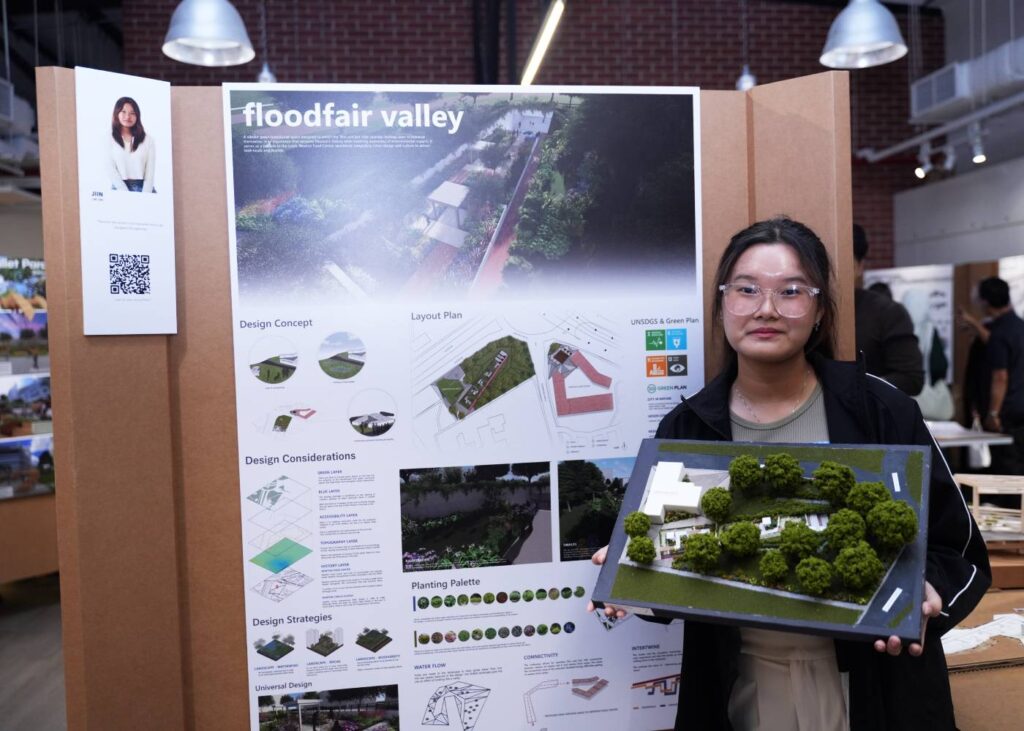
Lim Jiin: “During a visit to Newton Food Centre, I noticed two major issues: a lack of safe and accessible pathways for elderly and disabled pedestrians from Newton MRT, and frequent water pooling near the station exit after heavy rain. This led me to explore a design that enhances connectivity while addressing flood risks.
Newton’s low-lying terrain makes it prone to water pooling, and with climate change causing more intense downpours, the problem is worsening. Upon reviewing the site’s history, I discovered that Newton Circus had experienced flash floods in 1969 and 1998, which suggests that it could potentially happen again. I also found that the area was once used to host lively Pasar Malams (night markets) several times a week, fostering strong community ties—something that was lost after the food centre was built.
My solution? A terraced underpass that improves accessibility while reviving the site’s communal spirit. Shelters along the walkway double as spaces for pop-up Pasar Malam stalls, restoring vibrancy. The design also includes sloped and ‘folded’ landscapes with ABC water features, which effectively manage runoff naturally, thereby reducing flood risks while enhancing the greenery. More than just functional, the space educates visitors on climate resilience and serves as a welcoming gateway to Newton Food Centre—reconnecting people with its past and safeguarding its future.”
A huge congratulations to all the students who poured their passion into every detail of their final-year projects. If you’re a design student searching for your next big idea, we hope these stories spark fresh inspiration for your own creative journey.
Wondering what we’re up to next?
Give us a follow and stay in the loop!
About DSGN arcHive
DSGN arcHive is your exclusive key to unveiling the enigmatic essence of a city, all filtered through the prism of design. Far from the ordinary tourist paths. We reveal the city’s architectural marvels, urban intricacies, cultural tapestry, and eco-conscious revolutions that mold its distinctive soul. With us, you’re invited to savor the metropolis in an entirely chic and sophisticated light, a city that’s far more than what meets the eye.
Copyright © 2025 DSGN arcHive



